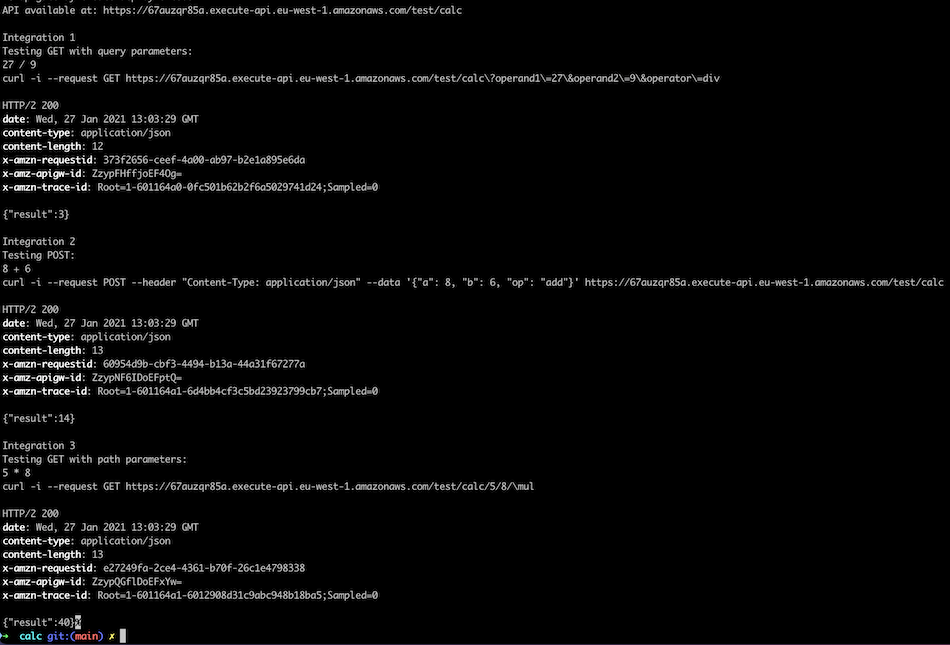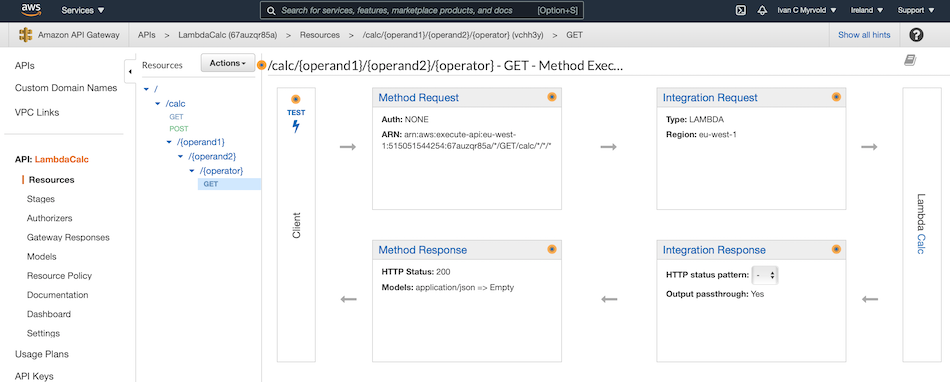Published 2021-01-28
Using Amazon API Gateway (Rest API) with Swift Lambda - Part 3
This is the last part in my blog posts about API Gateway and Lambda integration. The first part showed how we could integrate with GET query parameters, the second part showed the integration with POST method. This blog post will continue with integration with GET path parameters.
You can find the complete code of all 3 integrations in my GitHub repository.
Integration 3: Create a GET method with path parameters
Rename the 19 apigateway create-deployment... in scripts/setup_aws.sh script to 26 apigateway create-deployment... We will add the commands in the shell scripts between step 18 and step 26.
Add the first command in integration 3 to the shell script between step 18 and step 26:
# Integration 3
# Resources /{operand1}/{operand2}/{operator} GET
echo "19 apigateway create-resource..."
aws apigateway create-resource \
--region ${REGION} \
--rest-api-id ${API_ID} \
--parent-id ${RESOURCE_ID} \
--path-part {operand1} \
> results/aws/create-resource-operand1.json
[ $? == 0 ] || fail 19 "Failed: AWS / apigateway / create-resource"
RESOURCE_OPERAND1_PATH="$RESOURCE_NAME/{operand1}"
RESOURCE_OPERAND1_ID=$(aws apigateway get-resources --rest-api-id ${API_ID} --query "items[?path==\`/$RESOURCE_OPERAND1_PATH\`].id" --output text --region ${REGION})
We add a new resource, which contains the path of operand1. That means that the endpoint will contain the calc resource we created in step 6 of the first blog post plus the operand1 path part. We save the new path in RESOURCE_OPERAND1_PATH and the id of the new resource in RESOURCE_OPERAND1_ID, because they will be used in the next command.
We need a new resource for the second parameter:
echo "20 apigateway create-resource..."
aws apigateway create-resource \
--region ${REGION} \
--rest-api-id ${API_ID} \
--parent-id ${RESOURCE_OPERAND1_ID} \
--path-part {operand2} \
> results/aws/create-resource-operand2.json
[ $? == 0 ] || fail 20 "Failed: AWS / apigateway / create-resource"
RESOURCE_OPERAND2_PATH="$RESOURCE_OPERAND1_PATH/{operand2}"
RESOURCE_OPERAND2_ID=$(aws apigateway get-resources --rest-api-id ${API_ID} --query "items[?path==\`/$RESOURCE_OPERAND2_PATH\`].id" --output text --region ${REGION})
We have added a new path part in RESOURCE_OPERAND2_PATH and the new id for this resource in RESOURCE_OPERAND2_PATH, which will be used in the next command.
We also create a new resource for the operator:
echo "21 apigateway create-resource..."
aws apigateway create-resource \
--region ${REGION} \
--rest-api-id ${API_ID} \
--parent-id ${RESOURCE_OPERAND2_ID} \
--path-part {operator} \
> results/aws/create-resource-operator.json
[ $? == 0 ] || fail 21 "Failed: AWS / apigateway / create-resource"
RESOURCE_OPERATOR_PATH="$RESOURCE_OPERAND2_PATH/{operator}"
RESOURCE_OPERATOR_ID=$(aws apigateway get-resources --rest-api-id ${API_ID} --query "items[?path==\`/$RESOURCE_OPERATOR_PATH\`].id" --output text --region ${REGION})
We can now add the GET method to the operator resource:
echo "22 apigateway put-method..."
aws apigateway put-method \
--region ${REGION} \
--rest-api-id ${API_ID} \
--resource-id ${RESOURCE_OPERATOR_ID} \
--http-method GET \
--authorization-type NONE \
--request-parameters "method.request.path.operand1=true,method.request.path.operand2=true,method.request.path.operator=true" \
> results/aws/put-get-path-method.json
[ $? == 0 ] || fail 22 "Failed: AWS / apigateway / put-method"
We add the request parameters for operand1 and operand2 and operator.
Next we create the method response for the GET method, with statuscode 200:
echo "23 apigateway put-method-response..."
aws apigateway put-method-response \
--region ${REGION} \
--rest-api-id ${API_ID} \
--resource-id ${RESOURCE_OPERATOR_ID} \
--http-method GET \
--status-code 200 \
--response-models application/json=Empty \
> results/aws/put-method-response2.json
[ $? == 0 ] || fail 23 "Failed: AWS / apigateway / put-method-response"
Before we add the integration, we need to add the request-templates2.json JSON file:
{
"application/json":"{\n \"a\": $input.params('operand1'),\n \"b\": $input.params('operand2'),\n \"op\": #if($input.params('operator')=='%2F')\"/\"#{else}\"$input.params('operator')\"#end\n \n}"
}
This template maps the three URL path parameters into designated property values in the JSON object. We continue with adding the integration to the GET method with path parameters:
echo "24 apigateway put-integration..."
aws apigateway put-integration \
--region ${REGION} \
--rest-api-id ${API_ID} \
--resource-id ${RESOURCE_OPERATOR_ID} \
--http-method GET \
--type AWS \
--integration-http-method POST \
--uri arn:aws:apigateway:${REGION}:lambda:path/2015-03-31/functions/${LAMBDA_ARN}/invocations \
--credentials ${ROLE_ARN} \
--content-handling CONVERT_TO_TEXT \
--passthrough-behavior WHEN_NO_TEMPLATES \
--request-templates file://request-templates2.json \
> results/aws/put-get-integration2.json
[ $? == 0 ] || fail 24 "Failed: AWS / apigateway / put-integration"
The last command is the integration response:
echo "25 apigateway put-integration-response..."
aws apigateway put-integration-response \
--region ${REGION} \
--rest-api-id ${API_ID} \
--resource-id ${RESOURCE_OPERATOR_ID} \
--http-method GET \
--status-code 200 \
--response-templates application/json="" \
> results/aws/put-get-integration-response2.json
[ $? == 0 ] || fail 25 "Failed: AWS / apigateway / put-integration-response"
We have now completed all three integrations, and we just need to add the integration 3 testing commands at the end of the file:
echo
echo
echo "Integration 3"
echo "Testing GET with path parameters:"
echo "5 * 8"
cat << EOF
curl -i --request GET \
https://${API_ID}.execute-api.eu-west-1.amazonaws.com/${STAGE}/calc/5/8/\mul
EOF
echo
curl -i --request GET \
https://${API_ID}.execute-api.eu-west-1.amazonaws.com/${STAGE}/calc/5/8/\mul
Deploy Lambda function with API Gateway
Starting the script with scripts/setup_aws.sh will now give a result like this: 
If you test the new integration with Safari, it should look like this: 
Conclusion
The three blog posts have showed how we can make use of API Gateway's integrations to call a Lambda Swift function with
- GET method with query parameters
- POST method with body parameters
- GET method with path parameters
Log into your API Gateway console, to see how the final integrations looks like:
